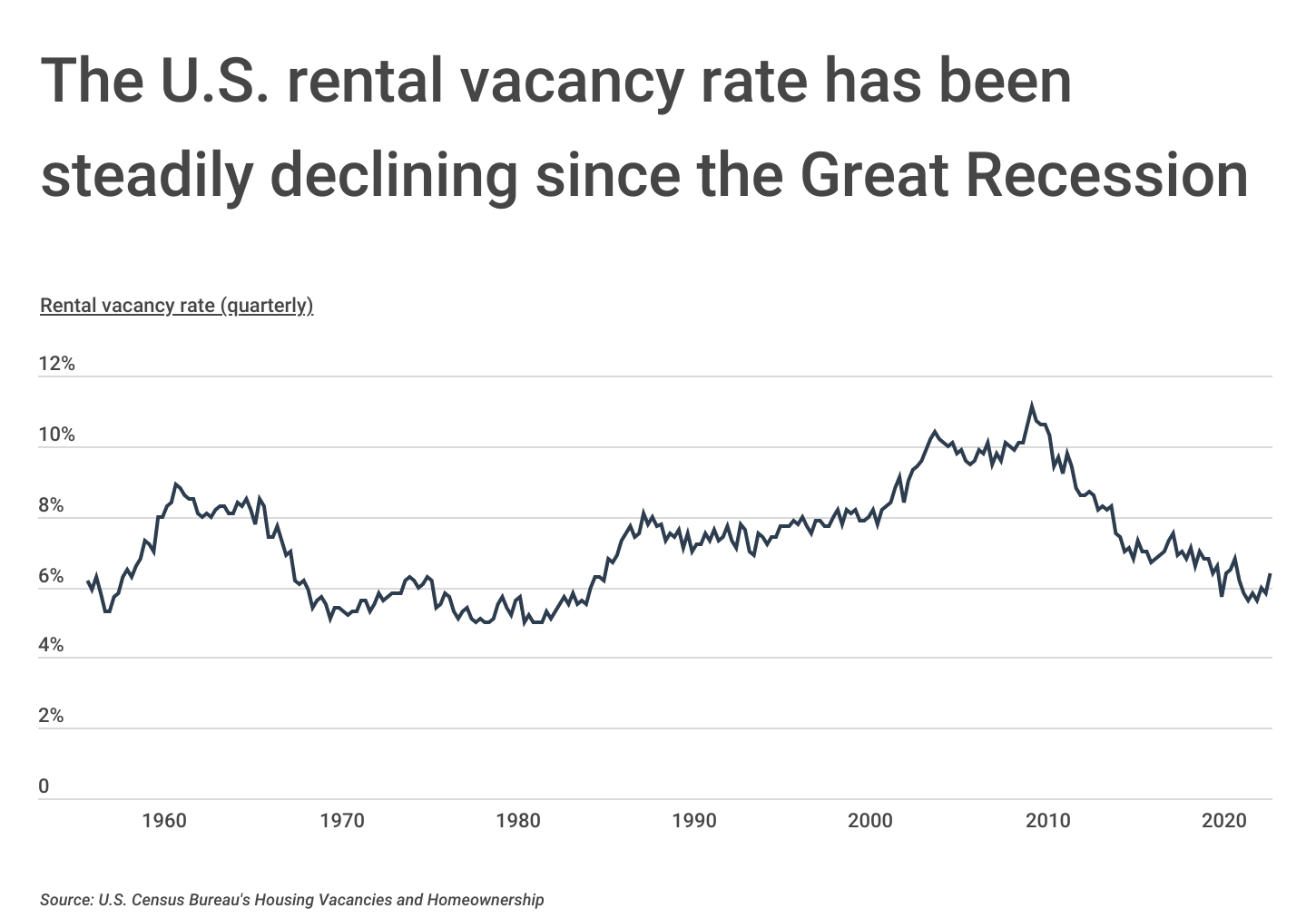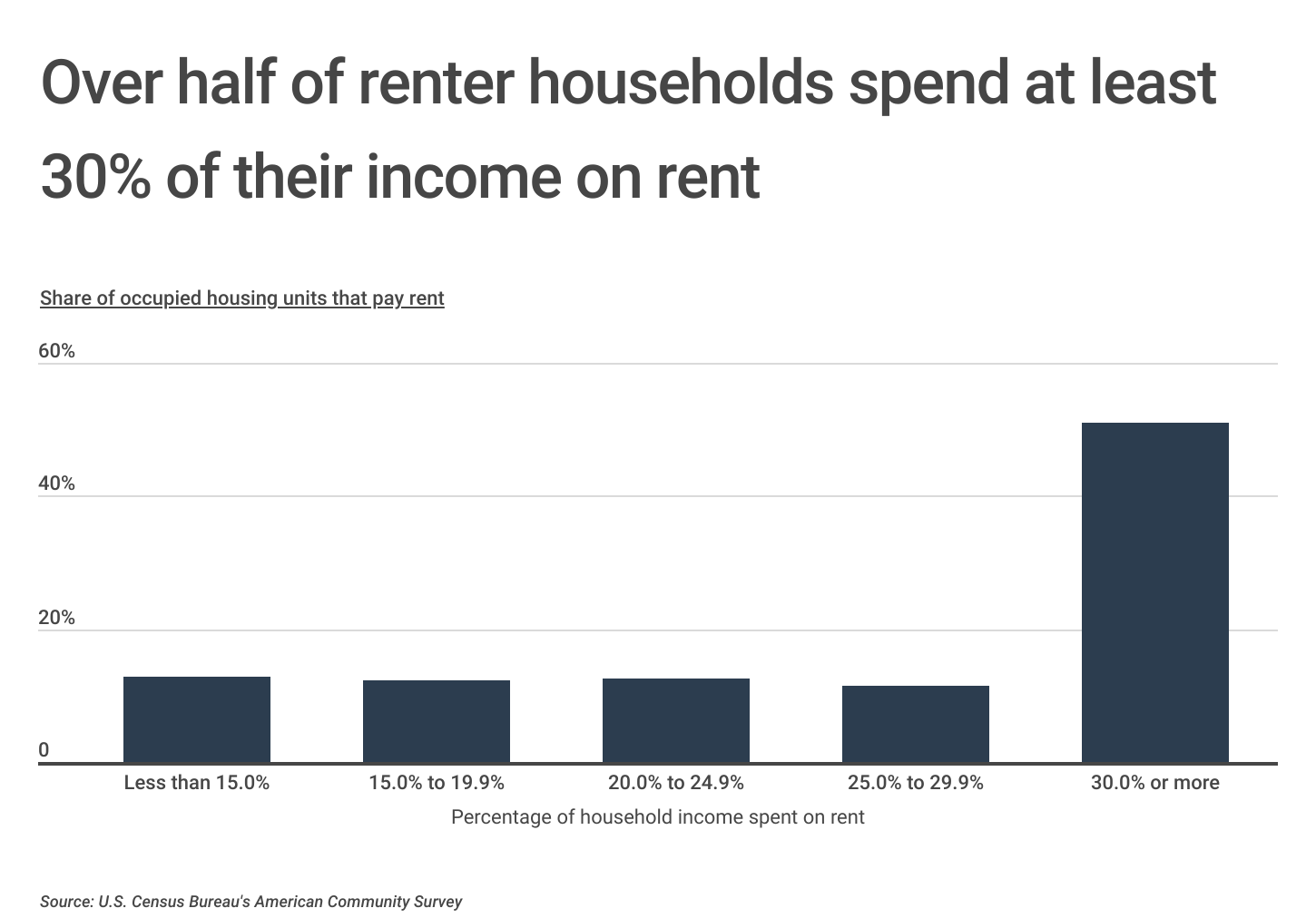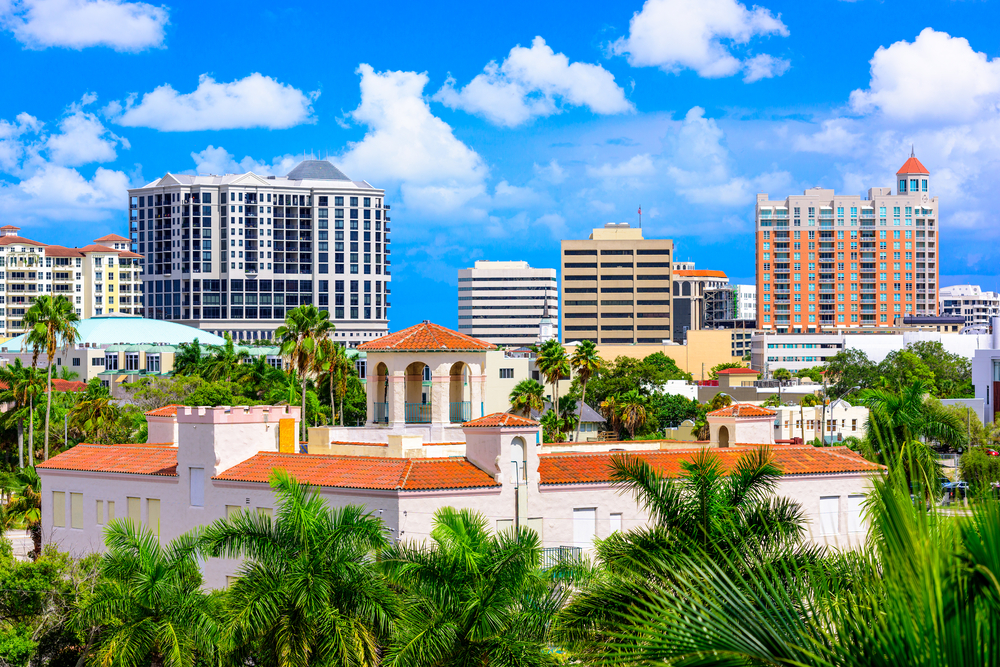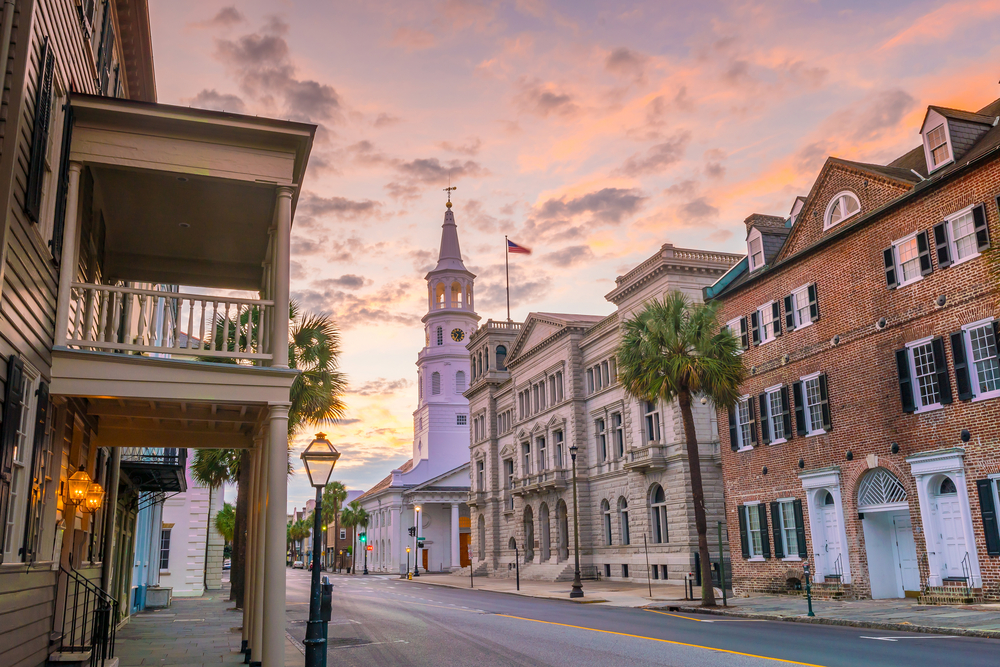American Cities With the Highest Rental Vacancy Rates in 2023
How and where people live saw a drastic transformation due to the COVID-19 pandemic. Following the initial lockdowns around the country aimed at slowing the virus’s spread, society reopened with a large emphasis on remote work and social distancing which led many to relocate away from city centers. Although some individuals migrated out of densely populated urban areas early on, with many relocating to more spacious and affordable Sun Belt states, a considerable number of people ended up moving to local suburban regions within the same metropolitan areas.
Typical migration patterns changed rapidly, wreaking havoc in the rental housing market. Many people leaving big cities desired to buy their own homes. However, the combination of historically low interest rates, millennials aging into the stage of life where homeownership is more appealing, and low housing supply created fierce competition in the real estate market, pricing out potential homebuyers. With a greater number of individuals remaining in the rental market, demand for rental units surged while rental vacancies dwindled.

The U.S. rental vacancy rate—or the measure of rental homes that are vacant in a given area—is facing a long-term decline. After a steady increase in the rental vacancy rate from the 80s through early 2000s, in part the result of increasing production of new housing units, the housing market crash and resulting Great Recession brought a dramatic reduction in housing investment and a rapid decline in rental vacancies. And although the pandemic produced an initial increase in rental vacancies as many rushed to purchase homes, the effect was short-lived and the downward trend continued through 2022.
The rental vacancy rate is an important economic indicator because it signals the balance between supply and demand for rental homes. When the rate is relatively high, it indicates an abundance of available rental properties, which typically places a downward pressure on rent prices. But with the rental vacancy rate being the lowest it’s been since the mid-80s, competition over available units is fierce and prices are historically high.
FOR CONSTRUCTION PROFESSIONALS
Insurers offer a variety of coverages that allow construction businesses to protect themselves from liability claims. To help you find the policies you need, we’ve put together insurance guides on the most common coverages, including:

The result is that many renters have no choice but to designate more and more of their income to rent. In fact, over half of renter households are spending at least 30% or more of their income on rent, and according to the Department of Housing and Urban Development (HUD), spending more than 30% of gross income on rent is generally considered unaffordable.
The consequences of unaffordable housing include having less money for individuals to spend on critical needs like food, healthcare, transportation, and child care, as well as being unable to save for critical life events like reducing debt and planning for retirement and family goals. The large percentage of Americans spending significant portions of their paycheck on rent helps explain the delay in parenthood for many and an increase in the average age of first-time homebuyers from 33 in 2021 to 36 in 2022.

While the federal government is attempting to address the housing affordability issue by closing the housing supply shortfall broadly across the nation, the housing problem is affecting certain areas more than others. Locations with lower rental vacancy rates can indicate a dwindling supply of rental units and increased need for rental housing solutions. Western and northeastern states have the lowest rental vacancy rates in the country, with 13 out of 15 states with the lowest vacancy rates belonging to the West or Northeast—all with rental vacancy rates of 4.5% or lower.
Conversely, southern and midwestern states tend to have more vacancies. All 15 states with the highest rental vacancy rates are located in the South or Midwest. Similarly, at the metropolitan level, the South and Midwest are home to 14 of the top 15 highest rental vacancy rates for metros, with the Charleston-North Charleston, SC area leading the nation at 15.3%.
The data used in this analysis is from the U.S. Census Bureau and the U.S. Department of Housing and Urban Development. To determine the locations with the highest rental vacancy rates, researchers at Construction Coverage, a construction and home improvement website, calculated the percentage of rental homes that are unoccupied in Q1 2023. In the event of a tie, the location with the greater percentage of households in occupied housing units that rent was ranked higher.
Here are the U.S. metropolitan areas with the highest rental vacancy rates.
The Metros With the Highest Rental Vacancy Rates

Photo Credit: Kit Leong / Shutterstock
15. Oklahoma City, OK
- Rental vacancy rate: 9.4%
- Percentage of households that rent: 36.1%
- Median monthly rent: $1,150
- Percentage of renters that are cost-burdened: 49.9%

Photo Credit: Mihai Andritoiu / Shutterstock
14. Albany-Schenectady-Troy, NY
- Rental vacancy rate: 9.5%
- Percentage of households that rent: 34.4%
- Median monthly rent: $1,408
- Percentage of renters that are cost-burdened: 46.7%

Photo Credit: Sean Pavone / Shutterstock
13. New Orleans-Metairie, LA
- Rental vacancy rate: 9.6%
- Percentage of households that rent: 34.8%
- Median monthly rent: $1,328
- Percentage of renters that are cost-burdened: 57.3%

Photo Credit: ESB Professional / Shutterstock
12. Atlanta-Sandy Springs-Alpharetta, GA
- Rental vacancy rate: 9.8%
- Percentage of households that rent: 33.1%
- Median monthly rent: $1,790
- Percentage of renters that are cost-burdened: 53.1%

Photo Credit: Steve Heap / Shutterstock
11. Nashville-Davidson–Murfreesboro–Franklin, TN
- Rental vacancy rate: 9.9%
- Percentage of households that rent: 33.1%
- Median monthly rent: $1,580
- Percentage of renters that are cost-burdened: 50.4%

Photo Credit: Checubus / Shutterstock
10. Minneapolis-St. Paul-Bloomington, MN-WI
- Rental vacancy rate: 10.1%
- Percentage of households that rent: 28.3%
- Median monthly rent: $1,496
- Percentage of renters that are cost-burdened: 48.9%

Photo Credit: CK Foto / Shutterstock
9. Dallas-Fort Worth-Arlington, TX
- Rental vacancy rate: 10.8%
- Percentage of households that rent: 40.2%
- Median monthly rent: $1,693
- Percentage of renters that are cost-burdened: 51.8%

Photo Credit: John Couture / Shutterstock
8. Raleigh-Cary, NC
- Rental vacancy rate: 10.9%
- Percentage of households that rent: 32.2%
- Median monthly rent: $1,644
- Percentage of renters that are cost-burdened: 50.0%

Photo Credit: Sean Pavone / Shutterstock
7. Indianapolis-Carmel-Anderson, IN
- Rental vacancy rate: 10.9%
- Percentage of households that rent: 32.4%
- Median monthly rent: $1,162
- Percentage of renters that are cost-burdened: 46.0%

Photo Credit: Sean Pavone / Shutterstock
6. Little Rock-North Little Rock-Conway, AR
- Rental vacancy rate: 11.2%
- Percentage of households that rent: 35.7%
- Median monthly rent: $1,077
- Percentage of renters that are cost-burdened: 50.1%

Photo Credit: Sean Pavone / Shutterstock
5. North Port-Sarasota-Bradenton, FL
- Rental vacancy rate: 11.8%
- Percentage of households that rent: 24.2%
- Median monthly rent: $1,816
- Percentage of renters that are cost-burdened: 55.4%

Photo Credit: Sean Pavone / Shutterstock
4. Birmingham-Hoover, AL
- Rental vacancy rate: 11.9%
- Percentage of households that rent: 29.6%
- Median monthly rent: $1,254
- Percentage of renters that are cost-burdened: 53.7%

Photo Credit: travelview / Shutterstock
3. Houston-The Woodlands-Sugar Land, TX
- Rental vacancy rate: 12.3%
- Percentage of households that rent: 38.5%
- Median monthly rent: $1,511
- Percentage of renters that are cost-burdened: 52.3%

Photo Credit: Jon Bilous / Shutterstock
2. Baltimore-Columbia-Towson, MD
- Rental vacancy rate: 12.8%
- Percentage of households that rent: 32.6%
- Median monthly rent: $1,716
- Percentage of renters that are cost-burdened: 53.2%

Photo Credit: f11photo / Shutterstock
1. Charleston-North Charleston, SC
- Rental vacancy rate: 15.3%
- Percentage of households that rent: 29.2%
- Median monthly rent: $1,804
- Percentage of renters that are cost-burdened: 52.5%
Detailed Findings & Methodology
The data used in this analysis is from the U.S. Census Bureau’s 2023 Housing Vacancies and Homeownership and the U.S. Department of Housing and Urban Development’s 2023 50th Percentile Rent Estimates. To determine the locations with the highest rental vacancy rates, researchers at Construction Coverage calculated the percentage of rental homes that are unoccupied in Q1 2023. In the event of a tie, the location with the greater percentage of households in occupied housing units that rent was ranked higher. Researchers also calculated the median monthly rent and percentage of renters that are cost-burdened, which are those renters who spend more than 30% of their income on rental housing. To improve relevance, only the largest 75 metropolitan areas with complete data were included in the analysis.
Each company featured in our guides has been independently selected and reviewed by our research team. If you select one of these companies and click on a link, we may earn a commission.
By clicking on these links, you may be taken to one of our insurance partners. The specific company listed here may or may not be included in our partner’s network at this time.
